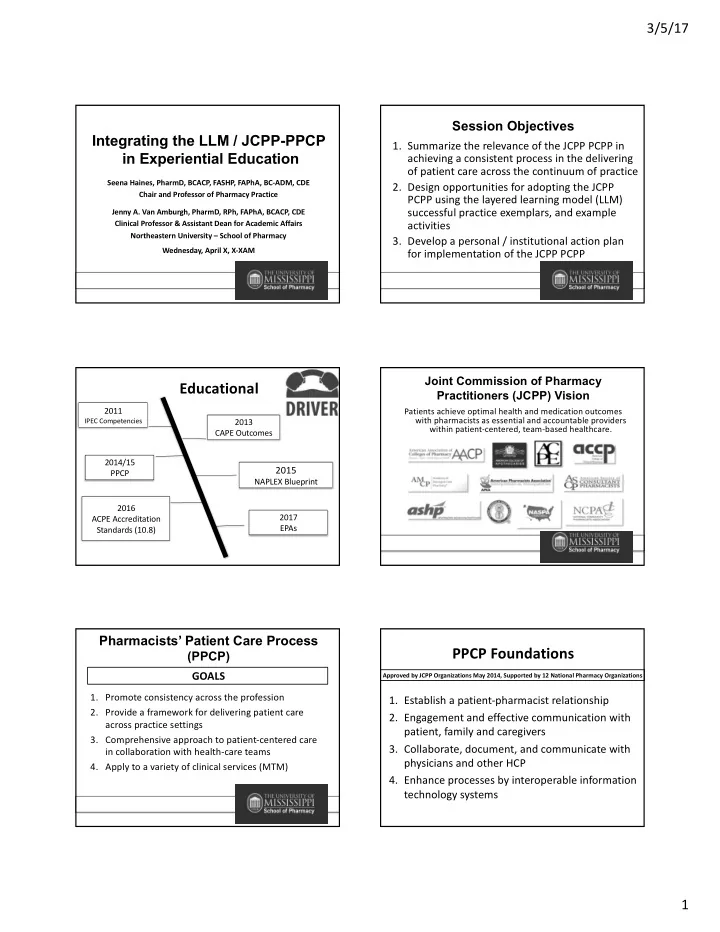

3/5/17 Session Objectives Integrating the LLM / JCPP-PPCP 1. Summarize the relevance of the JCPP PCPP in in Experiential Education achieving a consistent process in the delivering of patient care across the continuum of practice Seena Haines, PharmD, BCACP, FASHP, FAPhA, BC-ADM, CDE 2. Design opportunities for adopting the JCPP Chair and Professor of Pharmacy Practice PCPP using the layered learning model (LLM) successful practice exemplars, and example Jenny A. Van Amburgh, PharmD, RPh, FAPhA, BCACP, CDE Clinical Professor & Assistant Dean for Academic Affairs activities Northeastern University – School of Pharmacy 3. Develop a personal / institutional action plan Wednesday, April X, X-XAM for implementation of the JCPP PCPP Joint Commission of Pharmacy Educational Practitioners (JCPP) Vision 2011 Patients achieve optimal health and medication outcomes with pharmacists as essential and accountable providers IPEC Competencies 2013 within patient-centered, team-based healthcare. CAPE Outcomes 2014/15 2015 PPCP NAPLEX Blueprint 2016 2017 ACPE Accreditation EPAs Standards (10.8) Pharmacists’ Patient Care Process PPCP Foundations (PPCP) GOALS Approved by JCPP Organizations May 2014, Supported by 12 National Pharmacy Organizations 1. Promote consistency across the profession 1. Establish a patient-pharmacist relationship 2. Provide a framework for delivering patient care 2. Engagement and effective communication with across practice settings patient, family and caregivers 3. Comprehensive approach to patient-centered care 3. Collaborate, document, and communicate with in collaboration with health-care teams physicians and other HCP 4. Apply to a variety of clinical services (MTM) 4. Enhance processes by interoperable information technology systems 1
3/5/17 2013 CAPE Educational Outcomes ACPE Relevance Domain 2- Essential for Practice and Care Standard 10: Curriculum Design, Delivery, and Oversight 2.1 Patient-centered care (caregiver) Provide patient-centered care as the medication expert (collect, interpret evidence, prioritize, formulate assessments and recommendations, implement, monitor and 10.8 “Pharmacists’ Patient Care Process” adjust plans, and document activities). • 2.1.1 Collect subjective and objective evidence related to patient, medications, allergies/adverse reactions, and disease by performing patient assessment from The curriculum prepares students to provide patient- chart/electronic health records, and patient/family interviews. • 2.1.2 Interpret evidence and patient data. centered collaborative care as described in the • 2.1.3 Prioritize patient needs. Pharmacists’ Patient Care Process model endorsed by • 2.1.4 Formulate evidenced based care plans, assessments, and recommendations. 2.1.5 Implement patient care plans. • JCPP • 2.1.6 Monitor the patient and adjust care plan as needed. 2.1.7 Document patient care related activities. • Interprofessional Education Collaboration IPEC Core Competencies (IPEC) Model of Interprofessional Practice IPEC Core Competencies 2
3/5/17 Pharmacists’ Patient Care Process (PPCP) Educational Strategies NATIONAL STRATEGIES 1. Pharmacy HIT Collaborative – process framework for documentation in HER 2. The Pharmacy Quality Alliance (PQA) – developing quality measures 3. The Alliance for Integrated Medication Management (AIMM) Collaborative, Center for See Handout Medicare and Medicaid Innovation grantees in Education and Training Miller GE. The Assessment of clinical skills/competence/performance. Academic Medicine, 1990. Shumway JM. AMEE Guide No. 25: The assessment of learning outcomes for the competent and reflective physician. Medical Teacher. 2003 Layered Learning Practice Model Team System Approach Pharmacy Intern Resident Attending Pharmacist APPE Student (PGY2 / PGY1) IPPE Student AJPE. 2016;80(4):Article 68 Team STEPPS Communication High Functioning Teams • Hold shared mental • Engage in regular models feedback • Have clear roles and • Strong sense of responsibilities collective trust and confidence • Have a shared vision and values • Create mechanisms to cooperate and • Strong leadership team coordinate • Manage and optimize performance outcomes Salas, et al., 2004 3
3/5/17 Pharmacists’ Patient Care Process Pharmacists’ Patient Care Process • Subjective and objective information • Standards 2016 emphasize • Understand medication and medical history Basic Patient Collect ensuring our graduates are Assessment “practice-ready” and “team- • Analyze patient’s therapy in meeting goals ready” • Identify and prioritize problems Assess • Pre-APPE Performance Domains and Abilities • Individualized, patient-centered plan Identification • Collaboration, evidence-based, cost-effective Plan – Assessment data to document Assessment Resolution of student achievement Education DRP • Initiate, modify, discontinue as needed Communication • Education and coordination of care Implement Documentation • Clinical endpoints Follow- • Safety, effectiveness, adherence Citation : JCPP Pharmacists’ Patient Care Up Process. May 29, 2014. Available at: https://www.pharmacist.com/sites/default/f iles/files/PatientCareProcess.pdf See Handout Entrustable Professional Activities (EPAs) EPA Task Domains • Patient care provider • Interprofessional team member • Population health / care provider • Practice manager • Information master Readiness for independent practice • Self-developer Assess training progression Set of tasks / responsibilities Translate competencies to clinical practice Observable and measurable in process and outcome EPA Milestones in PharmD Education Levels of EPAs – Means of Assessment Level 5 = LLM? 4
3/5/17 Coloring the PPCP PPCP Steps A-E Pharmacists’ Patient Care Process, May 29, 2014 PPCP Steps A-E PPCP – Assess Pharmacists’ Patient Care Process, May 29, 2014 Medication Related Problems PPCP Steps A-E Gap in Care Therapeutic Duplication Nonadherence Opportunity to reduce costs Unnecessary medication therapy Dosage too low/high Adverse drug event Pharmacists’ Patient Care Process, May 29, 2014 5
3/5/17 PPCP Steps A-E PPCP Steps A-E Pharmacists’ Patient Care Process, May 29, 2014 Pharmacists’ Patient Care Process, May 29, 2014 Colleges / Schools Integrating the PPCP on Rotations • Integration into the curriculum v Consistent use of PPCP in • Skills / simulation labs practice by pharmacists v Enhanced delivery of patient • Didactic course work care through enhanced IPE collaboration • Integration into IPPEs / APPEs • Variability • Buy-in from preceptors Review as part of your orientation activities LLM- Best Practices • LLM • Community teaching hospital (part of the greater • Cleveland Clinic Florida Cleveland Clinic Health System) • University Hospitals of Geauga Medical Center • Pharmacy services: 40 FTEs / 3 PGY1s / 5 clinical specialists with 1-2 students per block • PPCP • PPMI evaluation: Identified that medication • Fairview Pharmacy Services reconciliation / discharge counseling was lacking • University of Pittsburgh SOP – Increase utilization of students – Integrate ‘real world’ patient care experiences into rotation learning ASHP NCPP 2016 . Constructing a layered learning model: considerations and opportunities 6
Recommend
More recommend